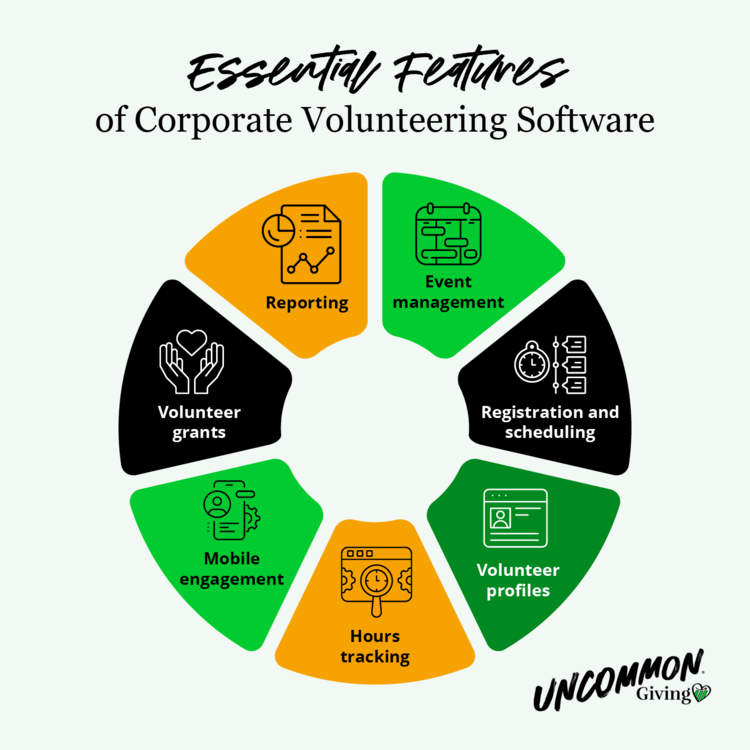
A thoughtful corporate social responsibility (CSR) strategy is a must-have for modern companies looking to stand out. While there are many ways to incorporate CSR into your business operations, one particularly meaningful and engaging approach is launching a corporate volunteering program. By getting your employees involved in the community, you can increase their sense of fulfillment and develop a reputation for social good.
In this guide, we’ll discuss five tips to improve your corporate volunteering program and maximize participation among your employees. Doing so can bring a host of benefits to your company, such as improved talent acquisition, higher customer loyalty, stronger teams, and sustained employee engagement.
1. Invest in comprehensive corporate volunteering software.
An effective corporate volunteering program involves many moving parts, from promoting volunteer opportunities to tracking employee involvement to measuring results. Regardless of the types of programs your organization is looking to promote (e.g., popular examples such as volunteer grants, paid volunteer time off, etc.), thanks to software solutions dedicated to streamlining corporate volunteering, none of these tasks have to be a burden on your company.
According to Uncommon Giving’s corporate volunteering platforms guide, some of the key features you can expect from this type of software include:
- Event management. Promote volunteer opportunities offered by nonprofits and create your own team or company-wide events.
- Registration and scheduling. Allow employees to search and sign up for volunteer shifts of their choosing.
- Volunteer profiles. Store key details about employee volunteering preferences, skills, and interests to make personalized recommendations.
- Hours tracking. Make it easy for employees to log their volunteer hours and manage their volunteer time off (VTO).
- Mobile engagement. Facilitate engagement with a mobile app that enables employees to check in, track hours, and share their volunteer experiences directly from their phones.
- Volunteer grants. If your company awards volunteer grants, the platform can automatically process requests based on the eligibility criteria you set.
- Reporting. Measure the impact of employee volunteers with real-time reports on participation, outcomes, and more.
Find the ideal solution for your company by conducting research into the top options online, reading reviews, and requesting demos to get a feel for the platforms you’re most interested in. Many corporate volunteering solutions come with additional tools that streamline other workplace giving program offerings such as matching gifts and payroll deductions.
With all of these features at your fingertips, your company can tap into all the benefits of CSR without getting bogged down in complicated processes or time-consuming program management activities.
2. Share a variety of corporate volunteering opportunities.
To make a real difference in your community, you need to get and keep your employees engaged in your corporate volunteering program. While using your corporate volunteering platform to promote opportunities is a start, it’s important to recognize that every employee will have different preferences for getting involved.
Boost participation by sharing and creating a variety of corporate volunteering initiatives, such as:
- Direct service. Volunteers in direct service roles will directly interact with nonprofit beneficiaries and other members of the community. For example, they might help out at a soup kitchen, socialize shelter animals, or assist elderly individuals at a senior center.
- Indirect service. Indirect service volunteers do not interact with beneficiaries. Instead, they might offer support by taking on data entry tasks, providing translation services, or creating marketing materials for a nonprofit.
- Skills-based. Skills-based roles allow volunteers to use their professional skills to help a nonprofit further its mission. For instance, your employees might lend their legal expertise or graphic design abilities for free.
- Virtual. For those of your employees who might not have as much time or resources to devote to volunteering, encourage them to consider fully virtual roles. In fact, 22% of volunteers regularly enjoy remote roles and 43% are open to trying them. For example, they could give language classes online or assist with social media management.
Furthermore, sharing micro-volunteering opportunities can be an effective way to introduce many of your employees to your program. These roles are minimal commitment and involve short tasks such as translating a single document or taking part in a short tutoring session.
3. Offer volunteer grants to employees.
Adding volunteer grants to your corporate volunteering program can be a strong incentive that inspires more employees to join in. This workplace giving initiative typically works like this:
- An employee volunteers regularly with a nonprofit.
- Once they reach a certain number of hours, the employee submits a volunteer grant request to your company.
- Your corporate volunteering software processes the request based on your pre-determined criteria.
- After confirming eligibility, your company sends funding to the nonprofit.
For example, your company might award $15 per volunteer hour after an employee contributes a minimum of 40 hours to a nonprofit. This type of opportunity allows your employees to make an even greater impact on the causes close to their hearts.
4. Seek out partnerships with nonprofits.
Some of your employees might be interested in volunteering, but they might not know where to start or what organization to get involved with. Consider concentrating your company’s volunteer efforts by building ongoing partnerships with specific nonprofits. While your employees will still have the freedom to volunteer for causes of their choice, you can host dedicated volunteer events with your nonprofit partners throughout the year.
You can go a step further than volunteering by becoming a sponsor for your nonprofit partners’ events. In return, the nonprofits can feature your company’s name and logo in their event marketing materials, bringing you added visibility and enhancing your reputation.
When seeking these mutually beneficial partnerships, aim to find nonprofits that align with your mission and values. For example, a technology company might partner with a nonprofit committed to providing digital literacy training to underserved communities.
5. Recognize employees for participating.
Keep your corporate volunteering program thriving by reinforcing employee participation. eCardWidget’s employee appreciation guide lists several methods you can use to recognize individuals for playing a part in your social impact, including:
- Sending an eCard.
- Posting social media shoutouts.
- Presenting certificates or awards.
- Handing out branded t-shirts or gift cards.
- Providing extra paid time off.
Whether or not you choose to use dedicated employee engagement tools to make your employee volunteers feel valued, be sure to personalize your recognition and highlight the impact of their involvement. In doing so, you’ll keep them invested for the long term in making a difference through your program.
As you continue to plan out improvements to your company’s volunteering program, use employee preferences and interests to guide you. Send out quarterly surveys to collect feedback on their experiences with your workplace giving software, the types of volunteering opportunities they prefer, and other adjustments that could increase their involvement. Before long, you’ll develop a strong, impactful program tailored to your company and its employees.